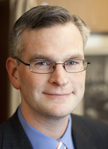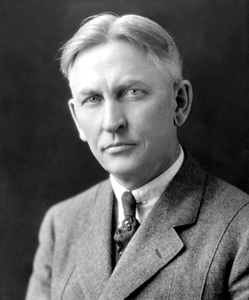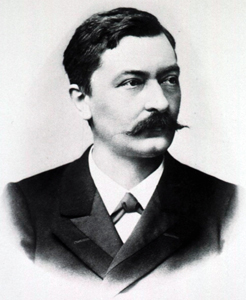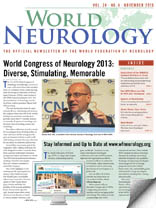
Christopher J. Boes, MD
Walter DeWitt Shelden was born Feb. 2, 1870, near Windom, Minn., He grew up in Reedsburg, Wis., and graduated from the University of Wisconsin in 1891. He attended RushMedicalCollege in Chicago, spent two years as an intern at CookCountyHospital in Chicago and worked as a general practitioner in Reedsburg for four years. He then received internal medicine training at the University of Vienna for 1.5 years, and for the next 10 years had a lucrative private internal medicine practice in Minneapolis and taught at the University of Minnesota Medical School. Shelden was asked by William J. Mayo to start the neurology section at the Mayo Clinic in 1913. He was head of the neurology section at the Mayo Clinic until 1930, and died on Feb. 13, 1946.
Shelden enrolled in courses at the Viennese Medical Faculty as a so-called frequentant (student) during winter term 1901/02, summer term 1902 and winter term 1902/03, staying in Vienna from Sept. 1, 1901, through Feb. 1,1903 (University of Vienna Archives). Approximately 10,000 Americans took some kind of formal

Walter DeWitt Shelden, MD. Photo courtesy of the Mayo Foundation for Medical Education and Research.
medical study at Vienna between 1870 and 1914. Almost the entire post-graduate work in Vienna was given in the Allgemeines Krankenhaus (2,250 beds in 1912).
It was written that “here one could do more eye operations, deliver more babies, treat more patients and conduct more post-mortems in a week than would be possible in a year in many parts of the United States (Bonner TN. American Doctors and GermanUniversities: A Chapter in Intellectual Relations, 1870-1914. Lincoln:
University of Nebraska Press, 1963).” Viennese clinicians were quick to encourage and exploit the interest of foreign doctors. Short practical courses of four to eight weeks were offered in the clinical branches of medicine, each limited to 10 or 12 students. In addition, adjunct professors and instructors arranged private courses. The internal medicine course given by Kovacs was controlled by Americans through a self-perpetuating membership.
Shelden worked with Edmund von Neusser (internal medicine), Friedrich Kovacs (internal medicine), Lothar von Frankl-Hochwart (neurology), Ernest Finger (syphilology and venereology) and Alois Monti (pediatrics). Frankl-Hochwart (1862-1914) was in charge of the outpatient unit for neurology and electrotherapy in the medical department at the University of Vienna, and was professor of pathology of the nervous system (although primarily a clinician) (JAMA 1915;LXIV:353; JNMD 1917;45:189-190). His 1891 monograph Die Tetanie contained the first summary of this disease’s clinical symptoms, and he also wrote important treatises on Meniè
re’s disease and neurogenic bladder (Lesky E. The ViennaMedicalSchool of the 19th Century. Baltimore: The JohnsHopkinsUniversity Press, 1976).
According to one of his students, Shelden “spent two years in Vienna, attending presentations of pathologic material and following von Neusser, whom he considered the greatest clinician he had ever known, in the wards of the Allgemeines Krankenhaus. [Shelden] said von Neusser ‘couldn’t write worth sour grapes,’ that to learn from him one had to observe him examining patients (Mayo Clinic Archives).”
Von Neusser (1852-1912), professor of internal medicine at the University of Vienna, was a master of diagnosis and differential diagnosis. Rumor had it that Neusser sent 140 patients to the dead-house without an error in diagnosis (Herrick JB. Memories of Eighty Years. Chicago: University of Chicago Press, 1949). Von Neusser had an active interest in diseases of the nervous system, and studied neurology in France, but did not become a specialist in neurology. He was “master of the whole of internal medicine” (Lesky, 1976).
These trips to Vienna by Americans were criticized by some, but most of this criticism was directed at those without prior internship and practice experience who had short stays, partied too much, did not speak the native language, and/or came after World War I. None of these things applied to Shelden. Interestingly, most courses for Americans in Vienna were in English, but Shelden learned German there. Learning the language was one of the reasons his mother encouraged him to go to Vienna. Shelden translated German articles for an American neurologic journal later in his career.
Shelden’s training in Vienna honed his clinical skills, exposed him to scientific medicine at the highest level, and had a significant influence on his subsequent medical career. His student Henry Woltman stated that “when the consultants gathered ‘round the autopsy table in the deadly game of turning face-down on the table a card bearing their name and diagnosis, Dr. Shelden was almost always right,” reminiscent of rumors of von Neusser’s diagnostic accuracy. Shelden exemplified the benefit of post-graduate training in Vienna before World War I for the well-prepared American physician.
Boes is an associate professor of neurology at the Mayo Clinic in Rochester, Minn.

